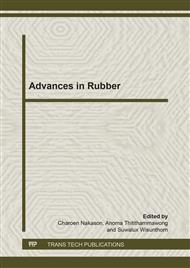p.454
p.458
p.462
p.466
p.470
p.474
p.478
p.482
p.486
Deproteinized Natural Rubber as Chewing Gum Base for Nicotine Delivery
Abstract:
This study aimed to prepare the nicotine chewing gums for smoking cessation using deproteinized natural rubber latex (DNRL) as gum bases due to its highly flexible property. The formulations were produced by the conventional heat melting and kneading methods. The experimental design was used to obtain the optimum 3 gum base formulations. Each formulation composed of olive oil as a plasticizer; sodium carboxymethylcellulose as an adsorbent; xylitol, mannitol and saccharin sodium as sweeteners instead of sugar. Gum base 1 and gum base 2 had the same sweetener amount but gum base 2 had the lower plasticizer amount, while gum base 1 and gum base 3 had the same plasticizer amount but different sweetener amount. Nicotine was added into each 3 gum bases (NCT1-3). The results showed no significant difference of appearance and taste. Their physicochemical properties were as following: pH of 8.45, 8.46, 8.54, hardness of 39.80, 36.28, 33.14 Shore A, initial modulus of 0.090, 1.260, 0.065 MPa, %elongation of 286, 403, 489%, drug content of 63.62, 70.95, 72.70%, and drug release when 500 times for force clamping of 48.72, 45.72, 67.74%, respectively. After storage at room temperature for 1 month, NCT1 and NCT2 showed unchangeable appearance, but NCT3 showed the slightly liquefied film and much sticky due to hygroscopic property of its sweetener. However, all formulations showed the significant reduction of drug amount which should be further improved in their stability properties.
Info:
Periodical:
Pages:
470-473
Citation:
Online since:
November 2013
Authors:
Price:
Сopyright:
© 2014 Trans Tech Publications Ltd. All Rights Reserved
Share:
Citation:


